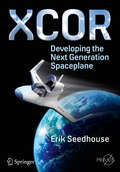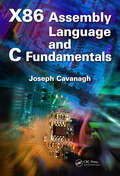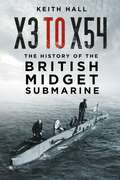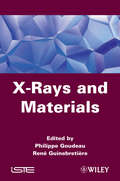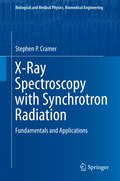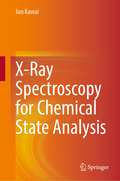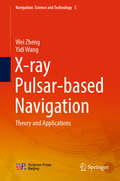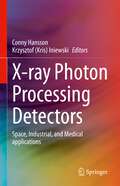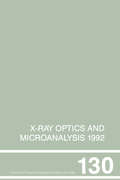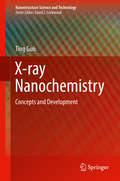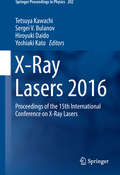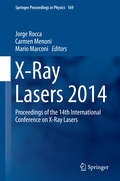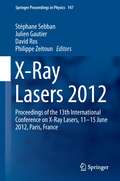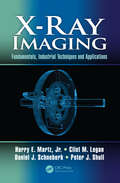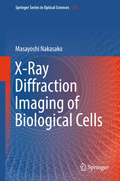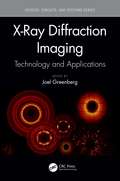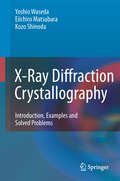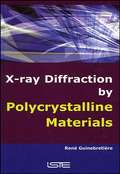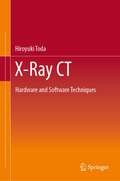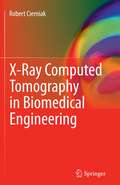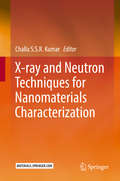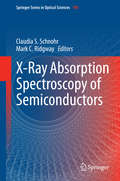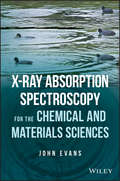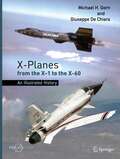- Table View
- List View
XCOR, Developing the Next Generation Spaceplane
by Erik SeedhouseEmploying the same informational approach Erik Seedhouse used in "SpaceX" and "Bigelow Aerospace", this new book familiarizes space enthusiasts with the company XCOR Aerospace and examines the design of the two-seater Lynx. The new spaceplane's low weight and high octane fuel confer important advantages, such as direct runway launches and the ability to fly several times per day. Over the last 15 years, XCOR has developed and built 13 different rocket engines, built and flown two manned rocket-powered aircraft and has accumulated over 4,000 engine firings and nearly 500 minutes of run time on their engines. This book serves as a go-to reference guide for suborbital scientists and those seeking to learn how one company has found success. Additionally, it describes the medical and training requirements for those flying on board the Lynx and the related critical roles of the astronaut trainers and a new breed of commercial space pilots. The end result is a thorough chronicle of the development of rocket propulsion, avionics, simulator and ground support operations being put into play by XCOR with the Lynx.
X86 Assembly Language and C Fundamentals
by Joseph CavanaghThe predominant language used in embedded microprocessors, assembly language lets you write programs that are typically faster and more compact than programs written in a high-level language and provide greater control over the program applications. Focusing on the languages used in X86 microprocessors, X86 Assembly Language and C Fundamentals expl
X3 to X54: The History of the British Midget Submarine
by Keith HallThe X Class submarines were conceived during WW2, small craft of around 51ft (16m) long, designed to be towed by a ‘mother’ submarine with a passage crew on board. Their midget size meant they could attack with stealth, and return to their towing submarine. Beginning with a look back over the wartime craft, this new study from ex-submariner Keith Hall charts the evolution of the X class subs, from X3 through X and XE, and onto the 1950s short-lived and unique Stickleback class. Only four Stickleback submarines were ever produced, with grand plans to use them to carry a 15-kiloton nuclear naval mine codenamed Cudgel deep into Soviet harbours. Nearly all scrapped, just one remains, an X51 now residing in the Scottish Submarine Centre in Helensburgh. With a wealth of imagery including archive X craft photographs as well as up-to-date views of the X51 Stickleback from the Helensburgh Museum, this book tells the little-known story of Britain's midget class subs.
X-Rays and Materials
by Philippe Goudeau René GuinebretièreThis book presents reviews of various aspects of radiation/matter interactions, be these instrumental developments, the application of the study of the interaction of X-rays and materials to a particular scientific field, or specific methodological approaches. The overall aim of the book is to provide reference summaries for a range of specific subject areas within a pedagogical framework. Each chapter is written by an author who is well known within their field and who has delivered an invited lecture on their subject area as part of the “RX2009 – X-rays and Materials” colloquium that took place in December 2009 at Orsay in France. The book consists of five chapters on the subject of X-ray diffraction, scattering and absorption. Chapter 1 gives a detailed presentation of the capabilities and potential of beam lines dedicated to condensed matter studies at the SOLEIL synchrotron radiation source. Chapter 2 focuses on the study of nanoparticles using small-angle X-ray scattering. Chapter 3 discusses the quantitative studies of this scattering signal used to analyze these characteristics in detail. Chapter 4 discusses relaxor materials, which are ceramics with a particularly complex microstructure. Chapter 5 discusses an approach enabling the in situ analysis of these phase transitions and their associated microstructural changes.
X-Ray Spectroscopy with Synchrotron Radiation: Fundamentals and Applications (Biological and Medical Physics, Biomedical Engineering)
by Stephen P. CramerSynchrotron radiation has been a revolutionary and invaluable research tool for a wide range of scientists, including chemists, biologists, physicists, materials scientists, geophysicists. It has also found multidisciplinary applications with problems ranging from archeology through cultural heritage to paleontology. The subject of this book is x-ray spectroscopy using synchrotron radiation, and the target audience is both current and potential users of synchrotron facilities. The first half of the book introduces readers to the fundamentals of storage ring operations, the qualities of the synchrotron radiation produced, the x-ray optics required to transport this radiation, and the detectors used for measurements. The second half of the book describes the important spectroscopic techniques that use synchrotron x-rays, including chapters on x-ray absorption, x-ray fluorescence, resonant and non-resonant inelastic x-ray scattering, nuclear spectroscopies, and x-ray photoemission. A final chapter surveys the exciting developments of free electron laser sources, which promise a second revolution in x-ray science. Thanks to the detailed descriptions in the book, prospective users will be able to quickly begin working with these techniques. Experienced users will find useful summaries, key equations, and exhaustive references to key papers in the field, as well as outlines of the historical developments in the field. Along with plentiful illustrations, this work includes access to supplemental Mathematica notebooks, which can be used for some of the more complex calculations and as a teaching aid. This book should appeal to graduate students, postdoctoral researchers, and senior scientists alike.
X-Ray Spectroscopy for Chemical State Analysis
by Jun KawaiThis book focuses on X-ray spectroscopy for chemical state analysis covering X-ray physics, spectroscopic characteristics used for functional and toxic materials, and the author's ideas related to X-ray experiments. This book also provides novel theoretical interpretations of X-ray spectra along with experimental techniques needed for both synchrotron radiation users and laboratory experimentalists. Presenting not only practical information, this book also covers basic knowledge of commercially available spectrometers and the basic physics of optics and electromagnetism related to X-rays. Furthermore, the author introduces the forgotten history of X-ray physics in the beginning of twentieth century. This book is of use for researchers studying catalysts, charge-transfer materials, surface characterization, and toxic trace elements via X-ray spectroscopy for chemical state analysis as well as quantitative analysis.
X-ray Pulsar-based Navigation: Theory and Applications (Navigation: Science and Technology #5)
by Wei Zheng Yidi WangThis book discusses autonomous spacecraft navigation based on X-ray pulsars, analyzing how to process X-ray pulsar signals, how to simulate them, and how to estimate the pulse’s time of arrival based on epoch folding. In turn, the book presents a range of X-ray pulsar-based spacecraft positioning/time-keeping/attitude determination methods. It also describes the error transmission mechanism of the X-ray pulsar-based navigation system and its corresponding compensation methods. Further, the book introduces readers to navigation based on multiple measurement information fusion, such as X-ray pulsar/traditional celestial body integrated navigation and X-ray pulsar/INS integrated navigation. As such, it offers readers extensive information on both the theory and applications of X-ray pulsar-based navigation, and reflects the latest developments in China and abroad.
X-ray Photon Processing Detectors: Space, Industrial, and Medical applications
by Conny Hansson Krzysztof Kris IniewskiThis book provides readers a good overview of some of most recent advances in the field of hybrid pixelated detectors for X-ray imaging. Coverage includes both technology and applications, with an in-depth review of the research topics conducted at leading research institutions in the world. The conversion of the X-ray signal into an analogue/digital value is discussed, as well as a review of CMOS chips used for X-ray image sensors. Applications of hybrid pixel detectors are discussed, such as medical imaging, high energy physics, space, non-destructive testing and security. Provides coverage of a broad range of topics, from international experts in academia and industry;Includes in-depth analysis of how to optimize X-ray detection and electronics for X-ray detection;Covers both technology and applications in a number of different domains.
X-Ray Optics and Microanalysis 1992, Proceedings of the 13th INT Conference, 31 August-4 September 1992, Manchester, UK
by P.B. Kenway P.J. DukeThe first ICXOM congress held in Cambridge was the brain-child of Dr. Ellis Cosslett, founder of the Electron Optics Section of the Cavendish Laboratory. Dr. Cosslett pioneered research in x-ray optics and microanalysis and retained a close interest in all subject applications for this area of research, including physics, materials science, chemistry, and biology. X-Ray Optics and Microanalysis 1992 was held in his memory. At a special symposium, friends and colleagues reviewed the present status of research in x-ray optics and microanalysis. S.J. Pennycook of Oak Ridge National Laboratory, D.B. Williams of Lehigh University, J.A. Venables et al. of Arizona State University and Sussex University, and C. Jacobsen et al. of SUNY, Stony Brook are among the researchers whose papers are included in this volume.
X-ray Nanochemistry: Concepts And Development (Nanostructure Science And Technology Ser.)
by Ting GuoThis book describes the latest developments in the new research discipline of X-ray nanochemistry, which uses nanomaterials to enhance the effectiveness of X-ray irradiation. Nanomaterials now can be synthesized in such a way as to meet the demand for complex functions that enhance the X-ray effect. Innovative methods of delivering the X-rays, which can interact with those nanomaterials much more strongly than energetic electrons and gamma rays, also create new opportunities to enhance the X-ray effect. As a result, new concepts are conceived and new developments are made in the last decade, which are discussed and summarized in this book. This book will help define the discipline and encourage more students and scientists to work in this discipline. These efforts will eventually lead to formation of a full set of physical, chemical and materials principles for this new research field.
X-Ray Lasers 2016: Proceedings Of The 15th International Conference On X-ray Lasers (Springer Proceedings In Physics #202)
by Tetsuya Kawachi Sergei V. Bulanov Hiroyuki Daido Yoshiaki KatoDiscusses the latest research topics related to coherent x-ray sources.<P><P> Includes several new proposals for free-electron laser (FEL) using laser- accelerated electrons.<P> Describes the latest methodology and techniques for x-ray coherent diffraction imaging and x-ray interferometry.<P> These proceedings comprise a selection of invited and contributed papers presented at the 15th International Conference on X-Ray Lasers (ICXRL 2016), held at the Nara Kasugano International Forum, Japan, from May 22 to 27, 2016. This conference was part of an ongoing series dedicated to recent developments in the science and technology of x-ray lasers and other coherent x-ray sources with additional focus on supporting technologies, instrumentation and applications. <P> The book showcases recent advances in the generation of intense, coherent x-rays, the development of practical devices and their applications across a wide variety of fields. It also discusses emerging topics such as plasma-based x-ray lasers, 4th generation accelerator-based sources and higher harmonic generations, as well as other x-ray generation schemes.
X-Ray Lasers 2014
by Jorge Rocca Carmen Menoni Mario MarconiThese proceedings comprise invited and contributed papers presented at the 14th International Conference on X-Ray Lasers (ICXRL 2014). This conference is part of a continuing series dedicated to recent developments and applications of x-ray lasers and other coherent x-ray sources with attention to supporting technologies and instrumentation. New results in the generation of intense, coherent x-rays and progress toward practical devices and their applications in numerous fields are reported. Areas of research in plasma-based x-ray lasers, 4th generation accelerator-based sources and higher harmonic generation, and other x-ray generation schemes are covered. The scope of ICXRL 2014 included, but was not limited to: Laser-pumped X-ray lasers Discharge excitation and other X-ray laser pumping methods Injection/seeding of X-ray amplifiers New lasing transitions and novel X-ray laser schemes High Harmonic sources-Free-electron laser generation in the XUV and X-ray range Novel schemes for coherent XUV and X-ray generation XUV and X-ray optics and metrology-Driving laser technology Theory and modeling of X-ray gain medium and beam characteristics Applications of high brightness and ultrashort X-ray sources
X-Ray Lasers 2012
by Stéphane Sebban Julien Gautier David Ros Philippe ZeitounThese proceedings comprise of invited and contributed papers presented at the 13th International Conference on X-Ray Lasers (ICXRL 2012) which was held 11-15 June 2012 in Paris, France, in the famous Quartier Latin, inside the historical Center of Cordeliers. This conference is part of a continuing series dedicated to recent developments and applications of x-ray lasers and other coherent x-ray sources with attention to supporting technologies and instrumentation. New results in the generation of intense coherent x-rays and progress towards practical devices and their applications are reported in these proceedings, including areas of research in plasma-based x-ray lasers, 4th generation accelerator-based sources and higher harmonic generation. Recent achievements related to the increase of the repetition rate up to 100 Hz and shorter wavelength collisional plasma-based soft x-ray lasers down to about 7 nm are presented. Seeding the amplifying plasma with a femtosecond high-order harmonic of infrared laser was foreseen as the required breakthrough to break the picosecond frontier. Numerical simulations based on the Maxwell-Bloch model are presented in these proceedings, transposing the chirped pulse amplification technique to the x-ray domain in order to increase the time over which the femtosecond seed can be amplified. These proceedings also include innovative applications of soft x-ray lasers based on techniques and diagnostics relevant to topical domains such as EUV lithography, inertial confinement fusion, or warm dense matter physics.
X-Ray Lasers 1996: Proceedings of the Fifth International Conference on X-Ray Lasers held in Lund, Sweden, 10-14 June, 1996
by S Svanberg; C-G WahlströmX-Ray Lasers 1996 provides not only an overview and progress report on this fast moving field, but also important reference material on which future work can be built. Topics covered include collisional x-ray lasers, table-top x-ray lasers, beam optics, x-ray optics, OFI and photo-pumped schemes, capillary schemes, international laser facilities, XUV nonlinear mixing, alternative soft x-ray sources, diagnostics, and applications. The volume is an essential addition to the libraries of researchers in the field.
X-Ray Imaging: Fundamentals, Industrial Techniques and Applications
by Peter J. Shull Harry E. Martz Clint M. Logan Daniel J. SchneberkWhile books on the medical applications of x-ray imaging exist, there is not one currently available that focuses on industrial applications. Full of color images that show clear spectrometry and rich with applications, X-Ray Imaging fills the need for a comprehensive work on modern industrial x-ray imaging. It reviews the fundamental science of x-ray imaging and addresses equipment and system configuration. Useful to a broad range of radiation imaging practitioners, the book looks at the rapid development and deployment of digital x-ray imaging system.
X-Ray Diffraction Imaging of Biological Cells (Springer Series In Optical Sciences #210)
by Masayoshi NakasakoProvides the first book on coherent X-ray diffraction imaging technique using the X-ray free electron laser SACLA in Japan written by a leader in the field.<P><P> Introduces the history, theory and computational simulation regarding of coherent X-ray diffraction imaging.<P> Describes experimental setups developed by the author, as well as modelling software to analyze the data.<P> In this book, the author describes the development of the experimental diffraction setup and structural analysis of non-crystalline particles from material science and biology. Recent advances in X-ray free electron laser (XFEL)-coherent X-ray diffraction imaging (CXDI) experiments allow for the structural analysis of non-crystalline particles to a resolution of 7 nm, and to a resolution of 20 nm for biological materials. Now XFEL-CXDI marks the dawn of a new era in structural analys of non-crystalline particles with dimensions larger than 100 nm, which was quite impossible in the 20th century.<P> To conduct CXDI experiments in both synchrotron and XFEL facilities, the author has developed apparatuses, named KOTOBUKI-1 and TAKASAGO-6 for cryogenic diffraction experiments on frozen-hydrated non-crystalline particles at around 66 K. At the synchrotron facility, cryogenic diffraction experiments dramatically reduce radiation damage of specimen particles and allow tomography CXDI experiments. In addition, in XFEL experiments, non-crystalline particles scattered on thin support membranes and flash-cooled can be used to efficiently increase the rate of XFEL pulses. The rate, which depends on the number density of scattered particles and the size of X-ray beams, is currently 20-90%, probably the world record in XFEL-CXDI experiments. The experiment setups and results are introduced in this book. The author has also developed software suitable for efficiently processing of diffraction patterns and retrieving electron density maps of specimen particles based on the diffraction theory used in CXDI.
X-Ray Diffraction Imaging: Technology and Applications (Devices, Circuits, and Systems)
by Joel GreenbergThis book explores novel methods for implementing X-ray diffraction technology as an imaging modality, which have been made possible through recent breakthroughs in detector technology, computational power, and data processing algorithms. The ability to perform fast, spatially-resolved X-ray diffraction throughout the volume of a sample opens up entirely new possibilities in areas such as material analysis, cancer diagnosis, and explosive detection, thus offering the potential to revolutionize the fields of medical, security, and industrial imaging and detection. Featuring chapters written by an international selection of authors from both academia and industry, the book provides a comprehensive discussion of the underlying physics, architectures, and applications of X-ray diffraction imaging that is accessible and relevant to neophytes and experts alike. Teaches novel methods for X-ray diffraction imaging Comprehensive and self-contained discussion of the relevant physics, imaging techniques, system components, and data processing algorithms Features state-of-the-art work of international authors from both academia and industry. Includes practical applications in the medical, industrial, and security sectors
X-Ray Diffraction Crystallography
by Eiichiro Matsubara Kozo Shinoda Yoshio WasedaX-ray diffraction crystallography for powder samples is a well-established and widely used method. It is applied to materials characterization to reveal the atomic scale structure of various substances in a variety of states. The book deals with fundamental properties of X-rays, geometry analysis of crystals, X-ray scattering and diffraction in polycrystalline samples and its application to the determination of the crystal structure. The reciprocal lattice and integrated diffraction intensity from crystals and symmetry analysis of crystals are explained. To learn the method of X-ray diffraction crystallography well and to be able to cope with the given subject, a certain number of exercises is presented in the book to calculate specific values for typical examples. This is particularly important for beginners in X-ray diffraction crystallography. One aim of this book is to offer guidance to solving the problems of 90 typical substances. For further convenience, 100 supplementary exercises are also provided with solutions. Some essential points with basic equations are summarized in each chapter, together with some relevant physical constants and the atomic scattering factors of the elements.
X-Ray Diffraction by Polycrystalline Materials
by René GuinebretièreThis book presents a physical approach to the diffraction phenomenon and its applications in materials science. An historical background to the discovery of X-ray diffraction is first outlined. Next, Part 1 gives a description of the physical phenomenon of X-ray diffraction on perfect and imperfect crystals. Part 2 then provides a detailed analysis of the instruments used for the characterization of powdered materials or thin films. The description of the processing of measured signals and their results is also covered, as are recent developments relating to quantitative microstructural analysis of powders or epitaxial thin films on the basis of X-ray diffraction. Given the comprehensive coverage offered by this title, anyone involved in the field of X-ray diffraction and its applications will find this of great use.
X-Ray CT: Hardware and Software Techniques
by Hiroyuki TodaThis book provides easy-to-understand explanations to systematically and comprehensively describe the X-ray CT technologies, techniques, and skills used for industrial and scientific purposes. Included are many references along with photographs, figures, and equations prepared by the author. These features all facilitate the reader's gaining a deeper understanding of the topics being discussed. The book presents expertise not only on fundamentals but also about hardware, software, and analytical methods for the benefit of technical users. The book targets engineers, researchers, and students who are involved in research, development, design, and quality assurance in industry and academia.
X-Ray Computed Tomography in Biomedical Engineering
by Robert CierniakComputed Tomography gives a detailed overview of various aspects of computed tomography. It discusses X-ray CT tomography from a historical point of view, the design and physical operating principles of computed tomography apparatus, the algorithms of image reconstruction and the quality assessment criteria of tomography scanners. Algorithms of image reconstruction from projections, a crucial problem in medical imaging, are considered in depth. The author gives descriptions of the reconstruction methods related to tomography scanners with a parallel X-ray beam, trough solutions with fan-shaped beam and successive modifications of spiral scanners. Computed Tomography contains a dedicated chapter for those readers who are interested in computer simulations based on studies of reconstruction algorithms. The information included in this chapter will enable readers to create a simulation environment in which virtual tomography projections can be obtained in all basic projection systems. This monograph is a valuable study on computed tomography that will be of interest to advanced students and researchers in the fields of biomedical engineering, medical electronics, computer science and medicine.
X-ray and Neutron Techniques for Nanomaterials Characterization
by Challa S. S. R. KumarFifth volume of a 40 volume series on nanoscience and nanotechnology, edited by the renowned scientist Challa S. S. R. Kumar. This handbook gives a comprehensive overview about X-ray and Neutron Techniques for Nanomaterials Characterization. Modern applications and state-of-the-art techniques are covered and make this volume an essential reading for research scientists in academia and industry.
X-Ray Absorption Spectroscopy of Semiconductors
by Claudia S. Schnohr Mark C. RidgwayX-ray Absorption Spectroscopy (XAS) is a powerful technique with which to probe the properties of matter, equally applicable to the solid, liquid and gas phases. Semiconductors are arguably our most technologically-relevant group of materials given they form the basis of the electronic and photonic devices that now so widely permeate almost every aspect of our society. The most effective utilisation of these materials today and tomorrow necessitates a detailed knowledge of their structural and vibrational properties. Through a series of comprehensive reviews, this book demonstrates the versatility of XAS for semiconductor materials analysis and presents important research activities in this ever growing field. A short introduction of the technique, aimed primarily at XAS newcomers, is followed by twenty independent chapters dedicated to distinct groups of materials. Topics span dopants in crystalline semiconductors and disorder in amorphous semiconductors to alloys and nanometric material as well as in-situ measurements of the effects of temperature and pressure. Summarizing research in their respective fields, the authors highlight important experimental findings and demonstrate the capabilities and applications of the XAS technique. This book provides a comprehensive review and valuable reference guide for both XAS newcomers and experts involved in semiconductor materials research.
X-ray Absorption Spectroscopy for the Chemical and Materials Sciences
by John EvansA clear-cut introduction to the technique and applications of x-ray absorption spectroscopy X-ray Absorption Spectroscopy is being applied to a widening set of disciplines. Applications started with solid state physics and grew to materials science, chemistry, biochemistry and geology. Now, they cut across engineering materials, environmental science and national heritage — providing very detailed and useful information facilitating understanding and development of materials. This practical guide helps investigators choose the right experiment, carry it out properly and analyze the data to give the best reliable result. It gives readers insights to extract what they need from the world of large-scale experimental facilities like synchrotrons, which seem distant to many laboratory scientists. X-ray Absorption Spectroscopy for the Chemical and Materials Sciences seeks to educate readers about the strengths and limitations of the techniques, including their accessibility. Presented in six sections, it offers chapters that cover: an introduction to X-ray absorption fine structure XAFS; the basis of XAFS; X-ray sources; experimental methods; data analysis and simulation methods; and case studies. A no-nonsense introduction to the technique and applications of x-ray absorption spectroscopy Features Questions to support learning through the book Relevant to all working on synchrotron sources and applications in physics, materials, environment/geology and biomedical materials Four-color representation allows easy interpretation of images and data for the reader X-ray Absorption Spectroscopy for the Chemical and Materials Sciences is aimed at Masters-level and PhD students embarking on X-ray spectroscopy projects as well as scientists in areas of materials characterization.
X-Planes from the X-1 to the X-60: An Illustrated History (Springer Praxis Books)
by Michael H. Gorn Giuseppe De ChiaraForeword by Dr. Roger D. Launius, Former NASA Chief Historian For the past 75 years, the U.S. government has invested significant time and money into advanced aerospace research, as evidenced by its many experimental X-plane aircraft and rockets. NASA's X-Planes asks a simple question: What have we gained from it all? To answer this question, the authors provide a comprehensive overview of the X-plane’s long history, from the 1946 X-1 to the modern X-60. The chapters describe not just the technological evolution of these models, but also the wider story of politics, federal budgets, and inter-agency rivalries surrounding them. The book is organized into two sections, with the first covering the operational X-planes that symbolized the Cold War struggle between the U.S. and the U.S.S.R, and the second section surveying post-Cold War aircraft and spacecraft. Featuring dozens of original illustrations of X-plane cross-sections, in-flight profiles, close-ups, and more, this book will educate general readers and specialists alike.
